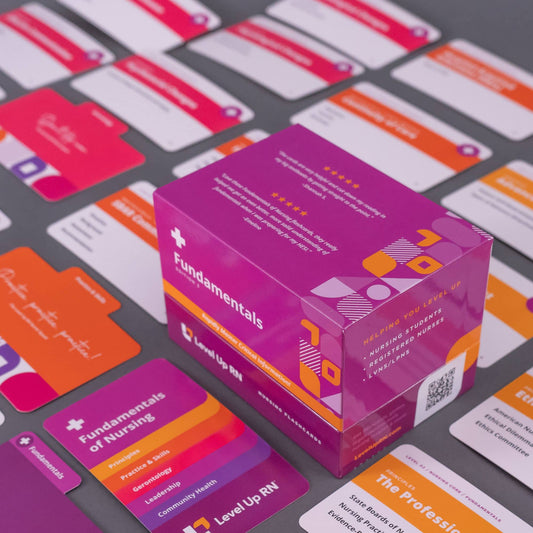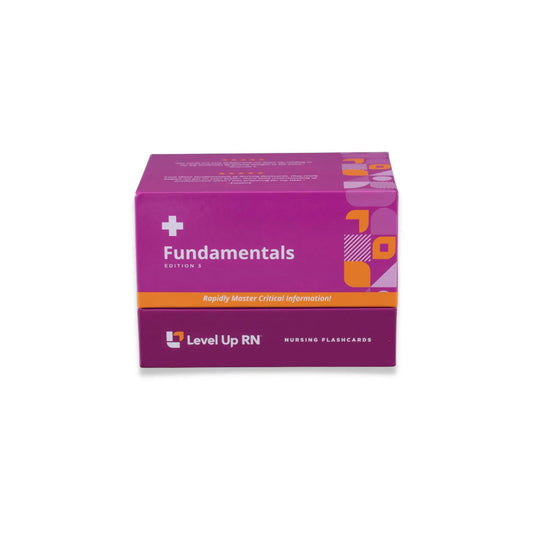Fundamentals of Nursing - Flashcards
This article covers laxatives, enemas, and fecal occult blood testing. You can follow along with our Fundamentals of Nursing flashcards, which are intended to help RN and PN nursing students study for nursing school exams, including the ATI, HESI, and NCLEX.
 When you see this Cool Chicken, that indicates one of Cathy's silly mnemonics to help you remember. The Cool Chicken hints in these articles are just a taste of what's available across our Level Up RN Flashcards for nursing students!
When you see this Cool Chicken, that indicates one of Cathy's silly mnemonics to help you remember. The Cool Chicken hints in these articles are just a taste of what's available across our Level Up RN Flashcards for nursing students!
Laxatives
Laxatives are medications that promote emptying of the intestinal tract. They are often prescribed to treat constipation.
The different kinds of laxatives include osmotic, bulk forming, and stimulant laxatives.
Osmotic laxatives
Osmotic laxatives are a type of medication used to treat constipation, as well as to prep the bowel prior to a surgery or procedure.
Bulk forming laxatives
Bulk forming laxatives are medications used for constipation, as well as to prevent straining and to help manage chronic watery diarrhea.
Stimulant laxatives
Stimulant laxatives are medications used for constipation, as well as for bowel prep prior to a surgery or procedure.
For a deeper dive into laxative pharmacology, please check out our pharmacology flashcards, which are intended to help RN and PN nursing students study for nursing school exams, including the ATI, HESI, and NCLEX.
Enemas
Enemas are solutions that are instilled into the intestinal tract via the rectum to help remove feces or to give medications to the patient.
As with laxatives, there are different types of enemas, including cleansing enemas and oil retention enemas.
Cleansing enemas
Cleansing enemas stimulate the colon to contract and eliminate stool. This type of enema may include large-volume cleansing enemas or prepackaged disposable enemas.
Oil retention enemas
Oil retention enemas lubricate the feces in the rectum and colon, making it easier to pass.
How to administer an enema (best practices)
- Have a bedside commode, bedpan, or bathroom ready for use
- Warm the enema solution to room temperature
- Elevate the solution less than or equal to 18 inches above the level of patient’s anus
- Position the patient in modified left lateral recumbent position (Sims'), on their left side with their right leg flexed
- Lubricate the enema tip if it is not pre-lubricated
- Insert the tip of the enema into the anus three to four inches (7.5 cm – 10 cm), angling the tip toward the umbilicus (belly button)
- Administer the enema slowly over 5 – 10 minutes
- If the patient reports abdominal cramping, lower the solution container
- Once administration is complete, encourage the patient to remain on their side and to retain contents, which means resisting toileting for about 10 minutes or as prescribed per order
- When it is time for the patient to toilet, assist them to the bathroom or bedside commode
Key nursing points when administering enemas
Why elevate the enema solution less than or equal to 18 inches above the patient?
The higher the bag, the more forcefully and faster the fluid is going to flow because of gravity. If the patient complains of cramping because of the rate at which the fluid is being instilled, try lowering the bag. When the bag is lowered, the rate at which the enema is delivered slows, and that may help with cramping.
Why instruct patients to resist the urge to toilet following an enema?
Patients should be instructed to resist the urge to toilet for approximately 10 minutes (or as prescribed per order) especially when being administered medicinal enemas. This is to ensure that the patient is retaining the medication for the prescribed amount of time. If the enema/medication comes out immediately, it won’t be effective.
Why lubricate the tip of an enema?
Lubricating the tip of an enema will ease its use and allow it to remain in the rectum longer. The longer the enema remains in the rectum, the more it’s going to help promote the expulsion of those fece (or administer the medicine).
Rectal suppositories
When administering a rectal suppository, position the patient in Sims’ position so that they are on their left side with the right leg flexed over. Then, insert the suppository about one inch into rectum.
It is important that the suppository gets past the internal sphincter so that it will stay inside the rectum, but it is not necessary to push the suppository too far. Also make sure to push the suppository along the wall of the colon so that it is not being pushed directly into stool, because then the suppository is not going to be effective.
Patient education for administering rectal suppositories
It is important to ensure the patient understands the process for inserting rectal suppositories in the event these are prescribed for home use and the patient is not being supervised by a nurse.
Digital removal
Digital removal is the manual removal of hardened stool in the rectum with a gloved, lubricated finger.
Fecal occult blood test
A fecal occult blood test is used to identify blood in stool, especially when blood may not be visible to the eye (occult means hidden; the test screens for blood that cannot be seen by the naked eye, e.g., microscopic blood).
Alternative names for this process include FOBT, occult blood testing, fecal blood test, or stool guaiac test.
Indications for administering a fecal occult blood test
Indications for fecal occult blood test include anemia, colon cancer screening, and GI disorders.
Instructions for administering a fecal occult blood test
When administering a fecal occult blood test, use an applicator to apply a small amount of stool onto the testing card slots A and B. The stool should be taken from two separate areas of the specimen in order to test for multiple areas in the stool to see if there’s bleeding anywhere along that line.
Apply reagent to the card; the card will turn blue if there is blood. If there is no blood, there will be no color change.
 If Blood is present, the card turns Blue.
If Blood is present, the card turns Blue.
If the test shows the presence of blood, the patient will require prompt evaluation (e.g., a colonoscopy).
Best practices for administering a fecal occult blood test
The following practices should be followed when administering a fecal occult blood test:
- Collect three samples from (three) separate bowel movements
- Collect stool in a clean container free from urine



3 comments
Thank you much for giving us the info on enemas. I need to know if it’s safe to get blood work drawn and do a enema in the same day?
Hello level Up,
I have your cards and there are very practical. Thank you for your information
Please continue to add the notes along with the transcript like the other Fundamental videos have! They are super helpful. I noticed the last 5 or so videos only have the transcript. Thanks!!!